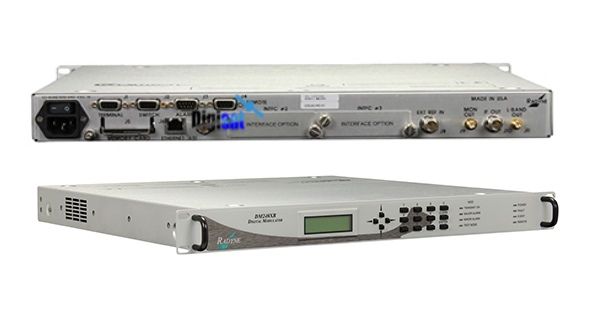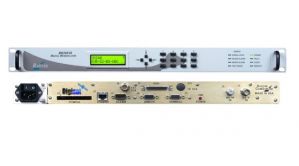Comtech Radyne DM240XR Digital Satellite Video Broadcast DVB-S2 Modulator
DVB-S2 data rates up to 190 Mbps
DM240XR DVB-S2 Modulator
The Comtech Radyne DM240XR DVB-S2 32APSK DSNG Broadcast Modulator offers an extremely adaptable broadcast modulator platform that's capable of DVB or DVB-S2 and 70/140 Mhz IF or L-Band operation. The Comtech Radyne DM240XR DVB-S2 32APSK DSNG Broadcast Modulator offers a great AutoEQ feature that supports Amplitude and Group Delay equalization over the satellite system. When installed, AutoEQ offers the ability to compensate the overall system Group Delay and Amplitude Flatness by precorrecting the Uplink Carrier. This eliminates the need for external Group Delay/Amplitude Equalizers and makes possible equalization at L-Band. The AutoEQ will operate over the full transponder from a symbol rate of 10.1 Msps to 45 Msps.
Features• DVB-S and DVB-S2 ready • DVB-S2 data rates up to 190 Mbps • DVB-S2 CM, VCM & ACM support • DVB-S data rates up to 238 Mbps • QPSK, 8PSK, 16-QAM, 16APSK, 32APSK • Embedded MetaCarrier DVB-CID ETSI TS 103 129 • Powerful LDPC with BCH coding • AutoEQ group delay and amplitude equalization |
• Frequency-agile 50 to 90, 100 to 180, and 950 to 2050 MHz • ETSI EN 302 307 (DVB-S2), ETSI EN 301 210 (DVB-S) • ETSI EN 300 421 and ITU-1294 System B (DSS) • Built-in ASI data interface • Monitor port available • Web browser user interface • Multiple 1:1 and 1:N redundancy options available |

MetaCarrier Technology
Comtech EF Data developed the MetaCarrier technology, which is used to embed and detect Carrier ID on video and data satellite carriers. The MetaCarrier name is derived from the method of providing transmission information via metadata. This is accomplished by spread spectrum modulation of a very low data rate carrier (containing metadata information about the referenced carrier) over a portion of the referenced carrier. A large spreading factor is used that results in spreading the meta-carrier’s energy over a significantly large amount of bandwidth – many orders of magnitude of the original metadata rate. The resulting energy becomes a nearly undetectable amount of noise being added to the referenced carrier spectrum. De-Spreading results in a coding gain that is used to extract and separate the MetaCarrier from its reference carrier.
MetaCarrier Carrier Identification has a minimal effect on the carrier quality and the quality of the carrier’s content. It can be read in the clear, by an MCDD, even if the referenced carrier is transmitted with conditional access or is otherwise encrypted. The MetaCarrier embedding can be used on any static carrier, SCPC, video or other.
The MetaCarrier technology overlays the very low data rate Carrier ID data in a spread spectrum carrier, onto the host carrier that it is referencing. In the below depiction, the MetaCarrier is placed 22 dB below the peak of the carrier it is identifying, at roughly the center frequency of the carrier.
AutoEQ Automatic Uplink Equalization System
The AutoEQ Automatic Uplink Equalization System is the most user friendly satellite communication system equalizer available. Unlike legacy analog equalizers which are difficult to adjust, the AutoEQ system is extremely easy to use. Transponder equalization is done in the digital domain; it is very accurate and can compensate for amplitude and group delay variations that are nearly impossible to compensate for with an analog equalizer.
The AutoEQ consists of special software built into the DM240XR coupled with a special digital receiver on a PIIC card. The receiver analyzes the signal path while the software computes the compensating equalizer values. Equalizing the link typically takes less than 2 minutes and can be done at the front panel or remotely.
A remote receiver capability is also supported for those systems where the DM240XR hub cannot see the return path from the distant end. Remote calibration is done by simply connecting and configuring the Ethernet control ports of the modulator and remote receiver to a network with internet access. The DM240XR takes care of the rest.
The AutoEQ Automatic Uplink Equalization System supports single channel per carrier (SCPC) equalization of group delay and amplitude over the entire satellite frequency range.
AutoEQ works with all modulation and coding types supported by the DM240XR (i.e. QPSK, 8PSK, 16-QAM for DVB-S and QPSK, 8PSK, 16APSK, and 32APSK for DVB-S2). The BER/bandwidth improvement is greater as the level of modulation increases.
The equalization process is nearly independent of receive signal to noise ratio. Accurate automatic equalization is possible down to the lowest specified levels of Eb/No associated with each modulation and coding type supported by the DM240XR.
The equalizer is based on the generation of complex coefficients. What this means is that it can even compensate for amplitude or group delay that is not symmetric over the carrier frequency spectrum, as would be the case if two independent carriers were placed on one transponder.
Up to 32 sets of equalization parameters can be stored within the DM240XR. This allows a DM240XR to be preconfigured for multiple carriers and multiple transponders.
Should the satellite uplink parameters change, recalibration of the AutoEQ can be easily initialized at any time, allowing for maximum flexibility for the uplink earth station.
The end result is greatly improved bandwidth and power utilization of your satellite transponder.
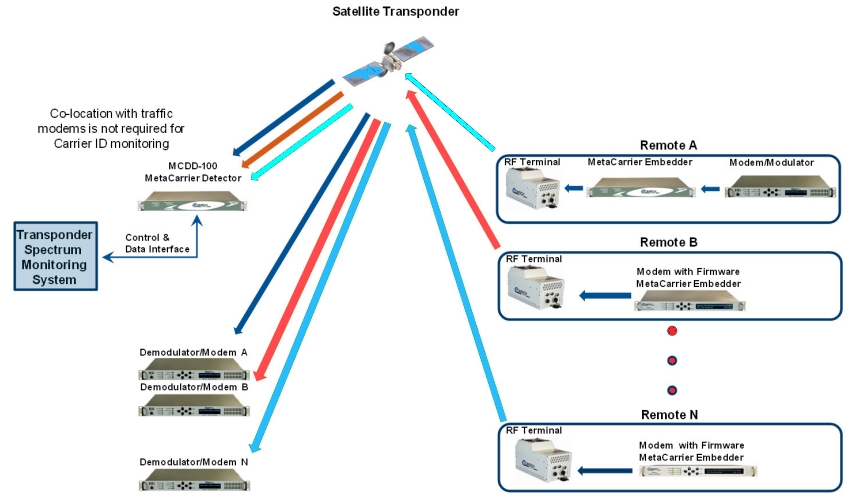
Additional Benefits
![]() Full or partial transponder (complex) equalization
Full or partial transponder (complex) equalization
![]() Digitized transponder characterization, plug and play
Digitized transponder characterization, plug and play
![]() No external adjustments required
No external adjustments required
![]() Easily upgradable into existing DMD240XRs
Easily upgradable into existing DMD240XRs
![]() Closed loop equalization using a plug-In PIIC receiver
Closed loop equalization using a plug-In PIIC receiver
![]() Supports all DM240XR modulation and frequency parameters up to 45 Msps
Supports all DM240XR modulation and frequency parameters up to 45 Msps
![]() Capable of multiplexing LNB power
Capable of multiplexing LNB power
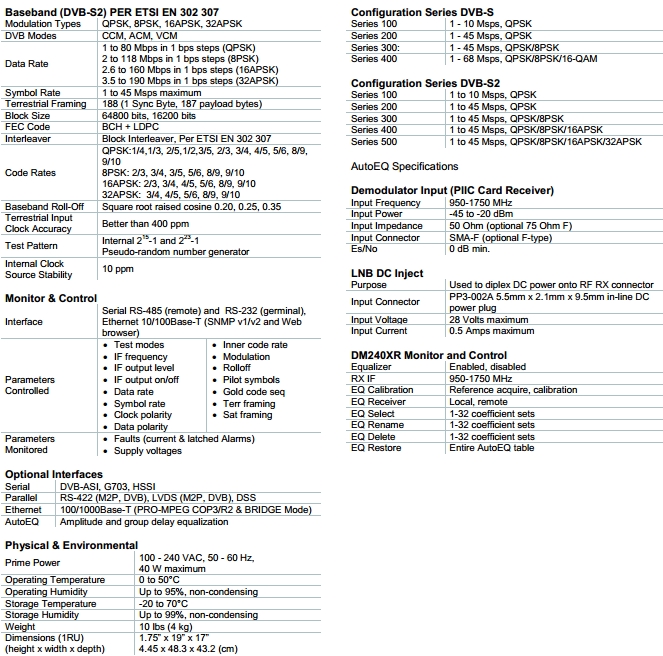
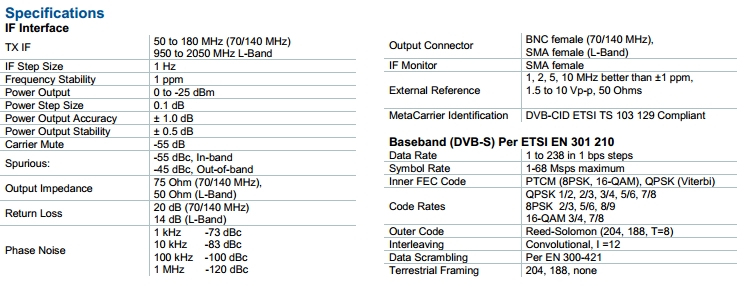
|
SpecificationsIF Interface |
|
|
TX IF |
50 to 180 MHz (70/140 MHz) 950 to 2050 MHz L-Band |
|
IF Step Size |
1 Hz |
|
Frequency Stability |
1 ppm |
|
Power Output |
0 to -25 dBm |
|
Power Step Size |
0.1 dB |
|
Power Output Accuracy |
± 1.0 dB |
|
Power Output Stability |
± 0.5 dB |
|
Carrier Mute |
-55 dB |
|
Spurious: |
-55 dBc, In-band -45 dBc, Out-of-band |
|
Output Impedance |
75 Ohm (70/140 MHz), 50 Ohm (L-Band) |
|
Return Loss |
20 dB (70/140 MHz) 14 dB (L-Band) |
|
Phase Noise |
1 kHz -73 dBc 10 kHz -83 dBc 100 kHz -100 dBc 1 MHz -120 dBc |
Users• Broadcasters • Internet Service Providers • Enterprise |
Common Applications |
|
• Direct To Home • Broadcast Contribution and Distribution • Satellite News Gathering • Broadband Interactive Services • Digital Cinema • Enterprise • High Speed Content Delivery • IPTV / Business Television |



